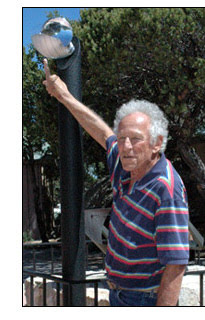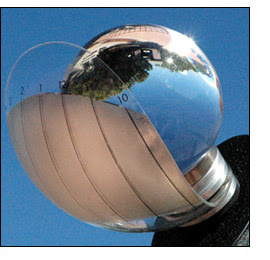TUCSON, Ariz., June 16 -- Stephen Jacobs said he had dreamed of building a sun clock since 1959, when he saw the Campbell-Stokes pattern sunshine recorder at the Stockholm Observatory while attending a meeting of The International Commission for Optics.
"It was so beautiful," said Jacobs, today a professor emeritus of optical sciences at the University of Arizona (UA). "I thought it would be great to make it into a clock, instead of a sunshine recorder."

Stephen Jacobs and his sun clock, which was installed last weekend at Kitt Peak Visitor Center. (Photo: Sheila Smith, NOAO)
His dream was realized last week when the sun clock he spent years designing was installed at the Kitt Peak National Observatory Visitor Center and Museum, part of the National Optical Astronomy Observatory (NOAO), in Tucson. NOAO is operated by the Association of Universities for Research in Astronomy (AURA) Inc., under a cooperative agreement with the National Science Foundation.
The Campbell-Stokes instrument -- still in use by meteorogists and researchers -- is a rare example of old technology that is as useful today as it was a hundred years ago. It uses a glass sphere to focus the sun's rays to an intense spot, which will char a mark on a curved card mounted concentrically with the sphere. As the earth rotates, the position of the spot moves across the card. When the sun is obscured, the trace is interrupted. At the end of the day the total length of the trace, less gaps, is proportional to the duration of sunshine.

The sun clock (Photo: Sheila Smith, NOAO)
The polished sphere of Jacobs' sun clock forms an image of the sun that moves 15 degrees per hour, enabling it to tell time. (The sun appears to make one revolution around the Earth every 24 hours, or 15 degrees per hour.)
Jacobs said it took 15 years to overcome "many interesting technical problems" to develop the clock, which yielded an unexpected discovery about the optics of a sphere.
"As soon as the polished sphere was finished, we got a big surprise," he said. "I mounted it in my window, expecting to see an aberrated image of the sun, but in addition there were two white rings that no one could explain. Turns out the optics of a sphere were never studied so thoroughly before modern ray-tracing was available. The rings proved to be due to 5 and 9 complete round trips reflecting within the sphere."
Jacobs copublished a paper on the phenomenon in October 1997. ("Unusual Optical Effects of a Solid Glass Sphere," Jacobs, Stephen F. and Johnston, Steve C. Optics & Photonics News [OPN], pp 44-45 and 72, Vol. 8, No. 10)
"The optics of a glass sphere were thought to be pretty well understood by then," Jacobs said. "For example, in his wonderful book The Rainbow ( Sagamore Press, 1959), Carl Boyer discussed the position, breadth and color arrangement for each of the rainbows of the first 19 orders (spherical water drop). That's a lot of ray tracing! And yet no one could explain the observed white rings whose picture we published in OPN."
The sun clock was a team effort: Corning Glass Works donated the fused silica material about 20 years ago; Charles Amling, a glassblower at UA, created the glass focal surface; Greg Lowe, of Photon Dynamics Inc., in Tucson, made the special durable reflective surface; James Izlar Sr. and James Izlar Jr., of Izlar Industries, built the mountings; James Hunnicutt, of Tucson Spraying Technology, spray-painted the mounting; and Mike Woods, of Southern Arizona Sandblasting Services, sandblasted it. Steve Johnston, vice president of research and development at Photon Engineering LLC, of Tucson, provided an optical analysis of the unexpected on-axis double ring, and Roland Shack, professor emeritus at UA, provided "constant encouragement," Jacobs said.
For more information, visit: www.optics.arizona.edu